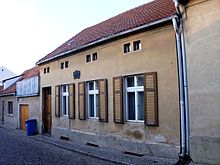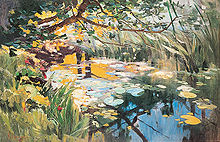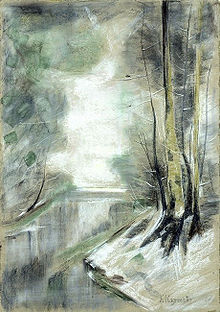Karl Hagemeister

Karl Hagemeister (born March 12, 1848 in Werder (Havel) ; † August 5, 1933 there ; also written Carl Hagemeister ) was a German painter whose independent late work shows elements of impressionism and expressionism at the same time.
Life

Karl Hagemeister was born on March 12, 1848 as the son of the fruit grower Carl Friedrich Hagemeister and his wife Luise Friederike Puhlmann in Werder an der Havel. The surrounding Havel landscape shaped his intensive relationship with nature and water. He received his first artistic training from his parents. Even as a schoolboy, Hagemeister caught the attention of the landscape painter Ferdinand Konrad Bellermann , who observed him painting in the park of Schönhausen Palace near Berlin.
Bellermann persuaded Hagemeister not to be trained as a drawing teacher, but as a painter. With his advocacy, Hagemeister was given the opportunity to receive training in Friedrich Preller's studio (who enjoyed the trust of Johann Wolfgang von Goethe and was allowed to draw him on his deathbed). From autumn 1871 to 1873 Hagemeister studied at the Princely Free Drawing School in Weimar with this representative of classicism . Preller was a supporter of the theory of colors and Goethe's view of nature and passed this teaching on to the young Karl Hagemeister , also through Philipp Otto Runge . This is where Hagemeister's terminology, the idea of unity and his rejection of the division of light comes from. From the summer of 1873, Hagemeister undertook several study trips to Rügen and Munich and to the Hintersee near Berchtesgaden . There Hagemeister made the acquaintance of his painter colleague Carl Schuch in 1873, with whom he traveled to Brussels at the end of 1873 . There the two Wilhelm Trübner joined in the spring of 1874 . In Brussels and on trips to Antwerp , Haarlem , Rotterdam and Amsterdam , the trio was able to study Dutch painting with Frans Hals , Rembrandt van Rijn and Jan Vermeer , among others . Hagemeister spent the years 1875 to 1876 in Italy; mostly in Venice and Pieve di Cadore .
According to Friedrich Preller's maxim, the three painted from nature . In his artistic development, Hagemeister dealt with Wilhelm Leibl's realism, among other things ; but was not part of the Leibl group . After this time on the road, Hagemeister returned to his homeland in Werder (Havel), where he spent most of his life. In the summer months of 1878 and 1881 he worked with Carl Schuch in Ferch am Schwielowsee and in 1880 in Kähnsdorf am Seddiner See. In the following years Hagemeister painted less pure landscape pictures and tried figurative works. Maidservants and peasant women from the surrounding villages served as models.
In 1884 Schuch persuaded Hagemeister to go on a study trip to France. They were particularly interested in the work of Gustave Courbet and Édouard Manet . It was here that contact with the Barbizon School took place, and with it a lively artistic exchange with the artists Jules Breton , Camille Corot , Charles-François Daubigny , Eugène Delacroix , Gustave Courbet and Théodore Rousseau . Hagemeister's friendship with Schuch broke up when he created his picture oysters in 1884 . The oysters, similar to those of Manet, appear abstractly impressionistic in contrast to the way in which Schuch and Hagemeister had previously painted realistically. A dispute arose among friends about the correct way of painting. "In 1883 I was in Paris with Schuch and I realized that the tonality is not the main thing for the pictures, but the light that changes forever."
During these years with Schuch, contact with contemporary European art was far greater than the native Berlin professors could; the Barbizon School in particular had a great influence on Hagemeister. In 1898 Hagemeister founded the Berlin Secession together with several colleagues, including Max Liebermann . Karl Hafenmeister began to work with photography at the end of the 19th century. Hagemeister used these new technical possibilities for the artistic implementation of his pictures. For this purpose, the first photo plates were purchased from 1884.
In the Havelland region around Potsdam Hagemeister lived as an undemanding hunter and as a fisherman and above all as a painter. Unlike many of his artist colleagues from the city, he did not come into nature, but lived in and from nature. The close connection to nature is also evident in the fact that he painted and drew directly in the landscape at all times of the year: even in deep winter and often with a self-made easel made of branches, which he folded up and hidden in the bushes after use. Hagemeister also made his own colors and began to paint with large chunks of oil pastel chalk. In the works that are now being created, subjects from nature dominate again. But Hagemeister's closeness to nature is also more noticeable in his still lifes . Hagemeister never saw himself as a teacher, but neither was anyone turned away who sought his artistic advice. During these years Hagemeister also maintained a lively correspondence with Lovis Corinth .
Over the years, Hagemeister has always had the opportunity to show one or the other picture at an exhibition. Among other things in the Munich Glass Palace in 1888, exhibitions of the Berlin Secession in 1891 and 1893. But it was not until the autumn of 1912 on the occasion of a large collective exhibition at the Heinemann Gallery in Munich that Hagemeister became known throughout Germany. The general public was able to obtain a comprehensive overview of Hagemeister's artistic development and range of his work from 87 paintings, pastels and drawings. In 1913 he was awarded the gold medal at the XI by the Bavarian king. International art exhibition in Munich awarded (Bavarian Order of Merit for Science and Art). In the period from 1908 to 1915, stays in Lohme on Rügen were of great importance to the artist. Large wave images are created here - often at wind force 10 - and the expressive beeches on the steep slope become a motif. The way of working is fast and very powerful after a phase of intensive absorption of mood, light and color tones.
With this “breakthrough” came financial success. However, this did not last long, as Hagemeister lost everything again in the economic situation and inflation after the First World War . Hagemeister fell ill in 1916, possibly from lead poisoning from white lead, and never recovered from it and has not painted since then. In 1923, the museum director Ludwig Justi organized a solo exhibition for Karl Hagemeister's works in the Berlin National Gallery on Museum Island. The press response was appreciative and the "great and unauthorized artist" was noticed with astonishment. In recognition of his artistic work, Hagemeister was accepted as a full member of the Akademie der Künste at the age of 75 in 1923 .
Karl Hagemeister also joined the Deutscher Künstlerbund soon after it was founded in 1903. Throughout his life, he sought contact with colleagues. Hagemeister was always interested in the latest developments in painting and was always informed about their latest status. Siegward Sprotte was his master student from 1930 to 1933.
Karl Hagemeister died at the age of 85 on August 5, 1933 in Werder an der Havel.
Hagemeister's entire artistic work can be divided into four periods:
- his early work as a student with Friedrich Preller,
- his apprenticeship and traveling years together with Carl Schuch,
- his turn to light-containing painting from 1884
- his late work (until 1916)
The painter Karl Hagemeister was an honorary citizen of the city of Werder / Havel. The German railway reminds her IC Karl Hagemeister at him.
A significant part of his works is exhibited in Berlin's Bröhan Museum , while the Potsdam Museum and the Museum in the Frey House in Brandenburg also have works by the artist in their archives.
A retrospective overview of the artist's painterly and graphic works from 1870 to 1916 opened on February 8, 2020, conceived for Potsdam. Loans from other museums and from private individuals are on display.
Quote
- “The landscape is quiet and graceful and actually only lives through the atmosphere that I have loved more and more recently. The mood is the bearer of the mental element of the landscape, and since I had to express mental impressions, I had to study the moods especially. I grasped it at a glance and fixed a main point, I only added everything else in passing, because the other things were indistinct and were flown over by light. When I wanted to express myself emotionally, I split the mood tone into two tones, the light tone and the shadow tone. I stroked this all over the canvas and developed all other things in their special tones from this great mood tone. In this way, the coloring of my pictures was harmonized organically and not just tastefully. I stayed with this type of representation all my life, whether the pictures were large or small ”[Small autobiography, 1928].
Works
(Selection)
- Cracked fallow deer calf, 1875
- Waterfall, Olevano, 1876
- Italian Landscape - Olevano, 1876
- Poppy pictures , 1877
- Houses in Ferch am Schwielowsee, 1878
- Fishing boat on the Havel landscape near Ferch, around 1878
- Waldstieg at Schwielowsee, 1880
- Island town Werder, 1881/1886
- Water roses, 1881
- Apple blossom, 1882
- Farm, around 1883
- Child on the Path, 1884
- Oysters , 1884
- At Kähnsdorf, around 1884
- Farmer's wife in a beet field, 1885
- Farmer's wife with a milk can on a poppy meadow in Havelland, 1886
- Boulders on a Hill, 1886
- Wendish peasant woman, 1886
- Tree blossom, Ferch, 1886
- Märkische Seenlandschaft, 1887
- Märkische Uferlandschaft, 1890
- Flying heron on the banks of the Havel, around 1891
- Young peasant woman in the forest, 1892
- Kemnitzer Heide, 1893
- Märkische Seenlandschaft at Schwielowsee, around 1893
- Angler on the banks of the Schwielowsee, 1897
- Four oil sketches for supraports in the Villa Hecht, 1910
- Lake shore with reeds, around 1900
- By the water, 1900
- Autumn, 1900
- Water lilies, 1902
- Birch trees by the river, 1902
- Märkische Herbstlandschaft, 1907
- Marine - Brandene See, 1907
- The Baltic Sea near Rügen, around 1907
- Beach at Lohme with rocks, 1908
- Seascape, 1910
- Autumn III, 1910
- Waves, ca.1910
- Pine branches I, 1911
- Ocean waves, 1912
- On the beach of Lohne in winter - beeches on the shore, 1912
- Heavy seas, 1913
- Moving sea, around 1913
- Pond in the marrow
- The revenge
- Hans view of Ferch
Fonts
- Carl Schuch. His life and works . Cassirer, Berlin 1913.
- Small autobiography . Werder 1928.
literature
- Exhibition Karl Hagemeister Werder . Galerie Heinemann, Munich 1912 ( digitized version ).
- Margrit Bröhan (Ed.): Karl Hagemeister (1848–1933). Paintings, pastels, drawings . Nicolai, Berlin 1998, ISBN 3-87584-698-2 .
- Anja Möller: Karl Hagemeister - from Werder to Lohme . Edition AB Fischer, Berlin 2006, ISBN 3-937434-13-5 .
- Karl Scheffler : The fat and the lean years , Leipzig 1946, pp. 106–118.
- Siegward Sprotte: Siegward Sprotte - In dialogue with Karl Hagemeister , catalog for the exhibition of the Museum of the Havelländische Malerkolonie (including a short autobiography). Friends of Havelländische Malerkolonie, Ferch 2010.
- Hans Vollmer: Hagemeister, Karl . In: Ulrich Thieme , Fred. C. Willis (Ed.): General lexicon of visual artists from antiquity to the present . Founded by Ulrich Thieme and Felix Becker . tape 15 : Gresse – Hanselmann . EA Seemann, Leipzig 1922, p. 459-460 ( Text Archive - Internet Archive ).
- Author: Hagemeister, Karl . In: Hans Vollmer (Hrsg.): General Lexicon of Fine Artists of the XX. Century. tape 2 : E-J . EA Seemann, Leipzig 1955, p. 353 .
- Hendrikje Warmt: The landscape painter Karl Hagemeister (1848–1933). On the way to modernity? Master's thesis at the Free University of Berlin 2005 (unprinted).
- Hendrikje Warmt: Hagemeister, Karl . In: General Artist Lexicon . The visual artists of all times and peoples (AKL). Volume 65, Saur, Munich a. a. 2009, ISBN 978-3-598-23032-5 , p. 418.
- Hendrikje Warmt: Karl Hagemeister. In reflection of the silence. Monograph and catalog raisonné of the paintings . Bebra Verlag, Berlin 2015, ISBN 978-3-95410-069-9 .
- Irmgard Wirth: Hagemeister, Carl. In: New German Biography (NDB). Volume 7, Duncker & Humblot, Berlin 1966, ISBN 3-428-00188-5 , p. 469 f. ( Digitized version ).
- Hendrikje Warmt: So close to the untouched at Schwielowsee, Hannah Schreiber de Grahl and Karl Hagemeister, ed. Mawa design, Michendorf 2018, ISBN 978-3-00-059921-7 . (Foreword by Jutta Götzmann, essay by Hendrikje Warmt: So close to the untouched at Schwielowsee. Hannah Schreiber de Grahl's encounter with the landscape painter Karl Hagemeister)
- Karl Hagemeister. "... the light that changes forever". Landscape painting of German impressionism , ed. by Jutta Götzmann and Hendrikje Warmt, on behalf of the Potsdam Museum - Forum for Art and History, Museum Georg Schäfer Schweinfurt and Art Museum Ahrenshoop. Contributions by Jutta Götzmann, Hendrikje Warmt, Katrin Arrieta, Roland Dorn, Karin Rhein, Oliver Max Wenske. Wienand Verlag, Potsdam 2020, ISBN 978-3-86832-558-4
Remarks
- ↑ Berlin Secession , accessed on November 1, 2017.
- ↑ Anja Möller: From Werder to Lohme .
- ↑ s. List of members in the catalog of the 3rd German Association of Artists Exhibition , Weimar 1906. P. 44 ( digitized version ).
- ↑ s. Sprat, Siegward . In: Hans Vollmer (Hrsg.): General Lexicon of Fine Artists of the XX. Century. tape 4 : Q-U . EA Seemann, Leipzig 1958, p. 334 .
Web links
- Literature by and about Karl Hagemeister in the catalog of the German National Library
- Works by and about Karl Hagemeister in the German Digital Library
- Hendrikje Warmt: Karl Hagemeister. Archive and catalog raisonné
- Havelländische painter colony
- Collection "Karl Hagemeister" in the City Museum Brandenburg ad Havel
- Karl Hagemeister Salon - Potsdam - in the il teatro: www.ilteatro-potsdam.de
| personal data | |
|---|---|
| SURNAME | Hagemeister, Karl |
| BRIEF DESCRIPTION | German impressionist painter |
| DATE OF BIRTH | March 12, 1848 |
| PLACE OF BIRTH | Werder (Havel) |
| DATE OF DEATH | August 5, 1933 |
| Place of death | Werder (Havel) |








